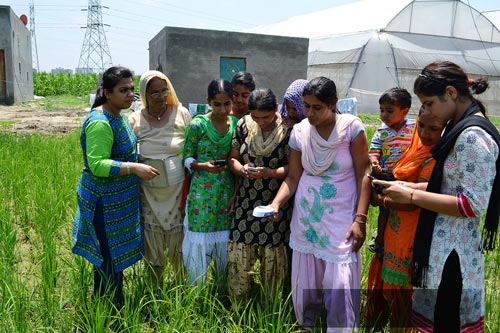The state of Haryana, India’s breadbasket, faces a major challenge due to the excessive use of nitrogen fertilizer (N: P: K = 27.2: 9.8: 1) in agriculture. The overuse of nitrogen fertilizer in the rice-wheat systems of Haryana has led to high production costs, low efficiency, environmental pollution and nitrate contamination of groundwater, which causes blue baby syndrome in young children.
Another challenge to agriculture in Haryana is that traditional ways of farming are no longer attractive to educated youth, which means that fewer young people are opting to become farmers. However, new innovations and technological advancements are making agriculture much more attractive to young people, especially women, and creating awareness and building capacity about these advancements is critical to make women see the potential in agriculture.
CIMMYT, under the CGIAR Research Program on Climate Change, Agriculture and Food Security, organized a day-long field training session for young female farmers in the climate-smart village of Bastada, Haryana, on the GreenSeeker, a hand-held sensor that measures nitrogen, assesses crop vigor and calculates a Normalized Difference Vegetation Index representing crop health. Nearly 20 young women from farm families in Bastada participated.
Farmers often lack training to interpret raw data from devices like the GreenSeeker. To address this problem, CIMMYT, the Indian Council of Agricultural Research and the Government of Punjab launched a mobile calculator application in January 2015 that allows farmers to precisely calculate the nitrogen in their fields right on their mobile phone, ensuring accurate nitrogen fertilizer application, which in turn raises crop yields and profits.
Mamta, a young woman of 23 who participated in the training session, mentioned that farmers faced a serious problem due to a shortage of urea during the winter 2014-15 wheat season. This problem is easier to avoid now that her cell phone has a GreenSeeker application that allows her to calculate the precise amount of nitrogen in her rice and wheat fields. “The application is very helpful in saving nitrogen to the tune of one bag of urea per hectare,” said Mamta.
CIMMYT plans to hold similar training sessions for young women and men throughout the states of Haryana, Punjab and Bihar, which will no doubt make them more likely to opt to become farmers and will go a long way towards ensuring adequate fertilizer application by farmers.

 Capacity development
Capacity development 
